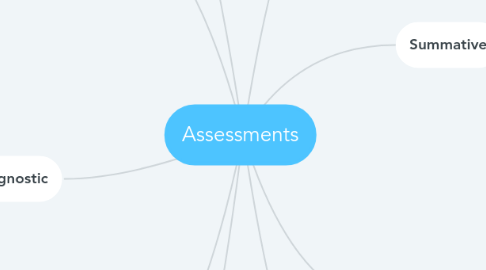
1. High-Stakes Testing
1.1. A testing program for which there are important consequences for students, teachers, administrators, or schools, based on the level of scores the students attain
1.1.1. Examples in my school: -standardized testing -incoming students tests -IEL program tests
1.1.1.1. Advantages: -Can provide a clear benchmark for students -Data is collected to help improve curriculums Disadvantages: -Can be really stressful -Not all students at the international level are taking this test
2. Formative
2.1. The use of assessments during the instructional process to monitor the progress of learning and the effectiveness of instruction so that adjustments can be made, as needed
2.1.1. Examples: -in class activities -homework assignments -observing and monitoring -exit tickets -class work and group discussions
2.1.1.1. Advantages: -according to Rick Wormeli, these on going types of assessments are incredibly important because of the descriptive feedback that is connected -lessons can be differentiated, areas can be retaught and students can gain a deeper understanding of what they are learning and areas of weakness to work on Disadvantages: -teachers tend to only use summative assessments for data collection -teachers only use methods like observation and "give me a thumbs up" instead of measurable formative -students can be overlooked
3. Diagnostic
3.1. a form a pre-assessment that allows a teacher to determine students' individual strengths, weaknesses, knowledge, and skills prior to instruction
3.1.1. Examples: -a pre-test -a warm up question posed at the beginning of a unit to assess prior knowledge
3.1.1.1. Advantages: -allowing teachers to gauge students level of understanding and differentiate where needed before the lesson has even started (in planning) -gives teachers an opportunity to focus the lesson and reduces wasted time Disadvantages: -some students may become anxious when give a pre-test
4. Authentic
4.1. An assessment containing items that are judged to be measuring the ability to apply and use knowledge in real-world contexts
4.1.1. Examples: -oral presentations -fitness exam in PE -creating art -summative in a collaborative unit
4.1.1.1. Advantages: -students are able to apply what they have learned in a lesson and present their understanding -students can be creative and often get excited about what they have learned Disadvantages: -some students may struggle with creative freedoms if they prefer more structure in instructions -assessments can be objective depending on the subject
5. Peer Asssessment
5.1. a collaborative learning technique, students evaluate their peers' work and have their work evaluated by their peers
5.1.1. Examples: -peer correction on quizzes and homework -peer grades on presentations -partner work
5.1.1.1. Advantages: -peer assessment gives students the opportunity to consider what is expected and how it is applied by assessing their classmates work and then thinking about how it applies to their own work -students often feel a boost in confidence in their own work when they understand the topic -valuable feedback can be given from peers Disadvantages: -some peers may not take the assignment seriously and give unhelpful feedback
6. Performance Based
6.1. The Office of Technology Assessment of the U.S.. Congress described performance assessment as testing that requires a students to create an answer or a product that demonstrates his or her knowledge or skills.
6.1.1. Examples: -End of the unit summatives, especially for PYP, MYP, and DP programs -Project Based Learning - students are presented with a problem, topic is introduced and taught, objectives are explained and given, students are expected to answer the given question using create knowledge
6.1.1.1. Advantages: -students are given creative freedom which helps them in the real world -involves a lot of student engagement which is usually fun for students Disadvantages: -there is a lot of responsibility placed on the student -if the student does not perform well, they will need to be retaught the lesson
7. Summative
7.1. Using assessments at the end of an instructional period to determine the level of students' achievement of intended learning outcomes or whether learning is complete enough to warrant advancing the student to the next segment of the sequence
7.1.1. Examples: -tests -quizes -collected and graded assignments -papers -unit projects
7.1.1.1. Advantages: -actual data is collected to assess students understanding -data can be used in grade level planning and expectations -students can follow their personal data to see growth and areas of weakness Disadvantages: -some students feel like their summatives are high stakes rather than a show of learning
8. Portfolio
8.1. A systematic collection of work samples provided by an individual to demonstrate their level of proficiency in some field or curricular area. Portfolios are used to document or determine growth or improvement.
8.1.1. Examples: -students artwork collected from the entirety of the school year -writing journals -videotapes of lessons/recitals/games
8.1.1.1. Advantages: -Gives students, parents, and teachers the ability to see the progression of learning and understanding throughout the school year -a more logical way of comparing and viewing progress as well as areas of struggle Disadvantages: -difficult to manage in all subject areas -does not provide concrete data
9. Self Assessment
9.1. involves students in evaluating their own work and learning process
9.1.1. Examples: -reflections at the end of units -self critiques -self checks on homework and quizzes -revisions on work
9.1.1.1. Advantages: -gives students a unique perspective in assessing their own work -students can see where they went wrong and why they got the grade they got -students can correct their work and by using a rubric have a clear understanding of what is expected Disadvantages: -if students are not given a clear understanding of what is expected and why it is expected, and how it should be applied, then the student might not learn from this.
